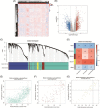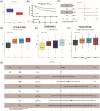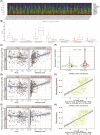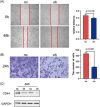Bioinformatics analysis of the prognosis and biological significance of VCAN in gastric cancer
- PMID: 33631054
- PMCID: PMC8127546
- DOI: 10.1002/iid3.414
Bioinformatics analysis of the prognosis and biological significance of VCAN in gastric cancer
Abstract
Gastric cancer (GC) is one of the most common cancers in the world, and the tumor microenvironment (TME) plays a vital role in the occurrence and development of GC. In this study, we obtained differential expressed genes in GC tissues from The Cancer Genome Atlas. After ESTIMATE and weighted correlation network analysis, we obtained differentially expressed genes (DEGs). With further screening DEGs of immune infiltration and then through Kaplan-Meier survival analysis, least absolute shrinkage and selection operator regression analysis and COX analysis, we found that VCAN was a gene positively correlated with high immune infiltration and poor prognosis of patients in GC. In addition, we selected a Gene Expression Omnibus dataset (GSE84433) to verify the effect of VCAN on the patient's prognosis, and analyzed the value of VCAN in immunotherapy through TIMER database and TISIDB. In conclusion, we hold the view that VCAN may affect the development of GC by regulating the TME, which may act as a potential therapeutic target for GC.
Keywords: VCAN; gastric cancer; immune infiltration; tumor microenvironment.
© 2021 The Authors. Immunity, Inflammation and Disease published by John Wiley & Sons Ltd.
Conflict of interest statement
The authors declare that there is no conflict of interest.
Figures






Similar articles
-
Identification of Prognostic Genes in the Tumor Microenvironment of Hepatocellular Carcinoma.Front Immunol. 2021 Apr 7;12:653836. doi: 10.3389/fimmu.2021.653836. eCollection 2021. Front Immunol. 2021. PMID: 33897701 Free PMC article.
-
Key Genes Associated with Prognosis and Tumor Infiltrating Immune Cells in Gastric Cancer Patients Identified by Cross-Database Analysis.Cancer Biother Radiopharm. 2020 Nov;35(9):696-710. doi: 10.1089/cbr.2019.3423. Epub 2020 May 13. Cancer Biother Radiopharm. 2020. PMID: 32401038
-
Versican enrichment predicts poor prognosis and response to adjuvant therapy and immunotherapy in gastric cancer.Front Immunol. 2022 Sep 20;13:960570. doi: 10.3389/fimmu.2022.960570. eCollection 2022. Front Immunol. 2022. PMID: 36203562 Free PMC article.
-
HIGD1B, as a novel prognostic biomarker, is involved in regulating the tumor microenvironment and immune cell infiltration; its overexpression leads to poor prognosis in gastric cancer patients.Front Immunol. 2024 Jul 23;15:1415148. doi: 10.3389/fimmu.2024.1415148. eCollection 2024. Front Immunol. 2024. PMID: 39108265 Free PMC article.
-
High expression of TMEM200A is associated with a poor prognosis and immune infiltration in gastric cancer.Pathol Oncol Res. 2023 Jan 19;29:1610893. doi: 10.3389/pore.2023.1610893. eCollection 2023. Pathol Oncol Res. 2023. PMID: 36741965 Free PMC article.
Cited by
-
Identification and verification of a glycolysis-related gene signature for gastric cancer.Ann Transl Med. 2022 Sep;10(18):1010. doi: 10.21037/atm-22-3980. Ann Transl Med. 2022. PMID: 36267782 Free PMC article.
-
The Regulatory Network of Gastric Cancer Pathogenesis and Its Potential Therapeutic Active Ingredients of Traditional Chinese Medicine Based on Bioinformatics, Molecular Docking, and Molecular Dynamics Simulation.Evid Based Complement Alternat Med. 2022 Nov 26;2022:5005498. doi: 10.1155/2022/5005498. eCollection 2022. Evid Based Complement Alternat Med. 2022. PMID: 36471693 Free PMC article.
-
SpaCcLink: exploring downstream signaling regulations with graph attention network for systematic inference of spatial cell-cell communication.BMC Biol. 2025 Feb 12;23(1):44. doi: 10.1186/s12915-025-02141-x. BMC Biol. 2025. PMID: 39939849 Free PMC article.
-
Identification of Versican as an Independent Prognostic Factor in Uveal Melanoma.Int J Gen Med. 2021 Aug 18;14:4639-4651. doi: 10.2147/IJGM.S325846. eCollection 2021. Int J Gen Med. 2021. PMID: 34434056 Free PMC article.
-
Achaete-scute complex-like 2 regulated inflammatory mechanism through Toll-like receptor 4 activating in stomach adenocarcinoma.World J Surg Oncol. 2022 Aug 25;20(1):266. doi: 10.1186/s12957-022-02722-y. World J Surg Oncol. 2022. PMID: 36008864 Free PMC article.
References
Publication types
MeSH terms
Substances
LinkOut - more resources
Full Text Sources
Other Literature Sources
Medical
Miscellaneous

